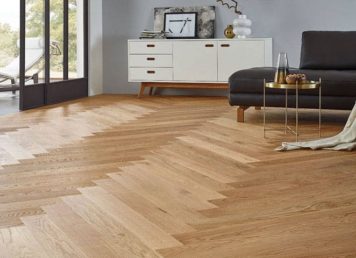Herringbone is in
It can be found in many historic buildings: herringbone parquet. This kind of parquet has been around for a long time and it seems as if it will never go out of style, in fact the herringbone pattern is more sought after than ever. Whether at international furniture fairs, in renowned interior design magazines or popular online platforms, the trend is everywhere, a fact which is reflected by an increasing demand.

The classic parquet pattern is experiencing a renaissance
Essentially what is Herringbone
“Herringbone parquet” is made by arranging individual pieces of parquet in a special shape, creating an unmistakable pattern. It is named the herringbone pattern due to its resemblance to the bones of a fish such as a herring. The pattern is created by laying blocks of parquet of a chosen length and width head to head at 90° angles. This results in rows of two parquet blocks, which are shaped like a typical herringbone.
Other patterns are achieved by arranging blocks in twos or threes, which is referred to as double or triple herringbone respectively.
For “French herringbone” the parquet blocks are bevelled at a 45° or 30° angle on both sides. This creates a continuous gap between the rows of parquet.
Visual effect
The jagged shape created by this classic pattern is guaranteed to give your wooden floor a unique and particularly striking look. However, this depends heavily on the size of the individual parquet blocks and how they are arranged. The floor can therefore have a very classy quality, a more striking presence in the room or something in between. Herringbone parquet really comes into its own in large rooms, as can be seen in the state rooms of numerous castles or in various museums and galleries. However, herringbone parquet has also long since found its way into smaller living spaces, where it works just as effectively.
Experience parquet
live in our Showrooms
Our Weitzer Parkett partners in your area will advise you on the perfect parquet format and its visual effect depending on the laying pattern.

Collection Herringbone parquet





















